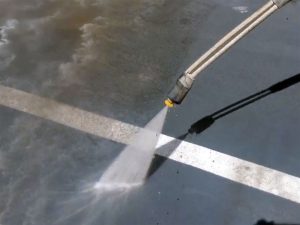 Sandblasters come in three types, but they all follow the same principle. They clean and abrade surfaces, particularly metal, by using the abrasive abilities of finely ground silica sand. Sandblasters come in handy for removing paint, rust or other surface debris. This works because sand blasting uses an air-powered pressure gun that blasts sand at high velocity against a particular surface.
Sandblasters come in three types, but they all follow the same principle. They clean and abrade surfaces, particularly metal, by using the abrasive abilities of finely ground silica sand. Sandblasters come in handy for removing paint, rust or other surface debris. This works because sand blasting uses an air-powered pressure gun that blasts sand at high velocity against a particular surface.
Since sand causes abrasion, the pressure gun has an interior coating or ceramic barrel to protect the tool from erosion. While the three different types of sandblasters use the same pressurized gun, the process by which the sand is fed to this part of the tool differs. The other parts that make up a sandblaster usually consist of some sort of air tank, a hopper or canister and various hoses. However, these components do differ from product to product.
Gravity-Fed Sandblaster
 The gravity-fed sandblaster has three main components. These comprise a hand-held pressure gun with air hose, a hopper and a pressurized air tank. The hopper sits on top of the pressure gun and holds silica sand. When you squeeze the gun’s trigger, compressed air flows through the gun for as long as the lever is down. Simultaneously, the area at the top of the gun that connects to the hopper opens up. The air combines with gravitational force unlike pressure washing to pull the sand down, through the tool and out the barrel.
The gravity-fed sandblaster has three main components. These comprise a hand-held pressure gun with air hose, a hopper and a pressurized air tank. The hopper sits on top of the pressure gun and holds silica sand. When you squeeze the gun’s trigger, compressed air flows through the gun for as long as the lever is down. Simultaneously, the area at the top of the gun that connects to the hopper opens up. The air combines with gravitational force unlike pressure washing to pull the sand down, through the tool and out the barrel.
Pressure Blaster
Commercial organizations commonly use pressure blasters because they’re easy to control and handle larger surfaces. However, they also cost more. A pressure blaster consists of a larger container filled with silica sand that’s under high pressure. This tool applies a concept similar to that of an aerosol can. A special hose connects to a port that is located at the top of the canister and attaches the container to the sandblasting gun.
 The sodablasting gun usually takes two hands to wield. When you pull the trigger, the sand and air come out together. This process is cleaner and requires little maintenance but does come with disadvantages. Since the containers are completely enclosed, you can’t reuse the sand that is fired out by the gun. Empty containers must be swapped out for full ones. This often requires the purchase of a new canister.
The sodablasting gun usually takes two hands to wield. When you pull the trigger, the sand and air come out together. This process is cleaner and requires little maintenance but does come with disadvantages. Since the containers are completely enclosed, you can’t reuse the sand that is fired out by the gun. Empty containers must be swapped out for full ones. This often requires the purchase of a new canister.
Siphon Sandblaster
Most handymen seem to use siphon sandblasters because of their ease of use and affordability. These are fairly inexpensive and useful for cleaning and stripping even large surfaces. A siphon sandblaster has three components: a sandblasting gun, an air compressor or normal pressurized tank and a container that functions as a reservoir to hold loose sand. This could even be a large bucket. The gun has two separate hoses. One of them connects to the underside of the barrel, and the other attaches to the bottom of the handle.
When the gun is engaged, the air creates suction. The resulting force serves to pull the sand up from the vessel and into the gun so that it can be released through the barrel. This Sandblasting Phoenix process allows for the reuse of sand because you can collect it and add the sand back into the reservoir numerous times.

